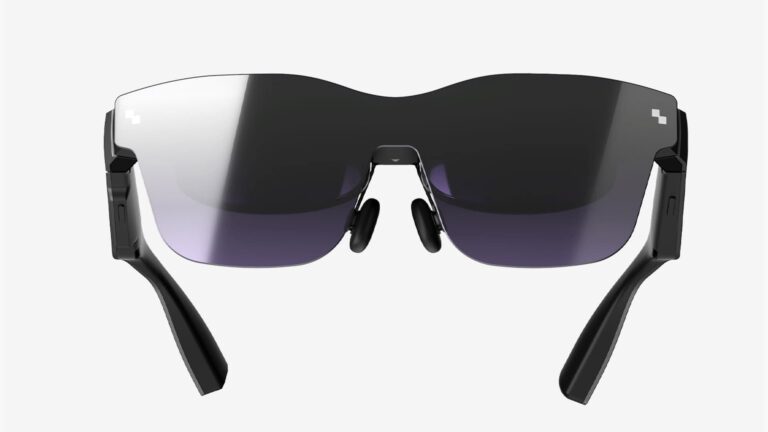
Among all the trends happening in the spatial computing world – including Apple Vision Pro and the ongoing convergence with AI – accelerated innovation in smart glasses sticks out. We’re talking about a generation of purpose-built devices that have more style and focus. By focus, we mean more emphasis on nailing specific use cases, rather than being a jack of all trades. They do this by flirting with, or landing in, the assisted reality category. In some cases, they don’t even have a display system and rely on ambient audio, including Chat GPT-fueled situational awareness.
After drilling down on a few exemplars in past articles – like Ray Ban Meta Smartglasses, XReal Air 2, Rayneo Air 2, and Solos AirGo3 – we now return to this series to examine the broader lay of the land. What hardware sticks out, and why?
Lucky Seven
Priced from $349 to $600, six new video smartglasses from six different companies (and one honorable mention) were introduced over the past six months. They constitute, or re-constitute, the category of Assisted Reality. As opposed to Augmented Reality, where data is combined with the physical world, Assisted Reality refers to a microdisplay in, or slightly adjacent to, your field of view, like the original Google Glass.
Glass faded away from consumer view but became a ruggedized wearable screen which kept front line workers’ hands free but eyes on the task, ideal for manufacturing and logistics applications. Glass was sunset earlier this year, but many companies like Vuzix and RealWear continue to provide microdisplays to business.
Microdisplays are now cheap enough to come back to consumers as a relatively low-cost wearable mobile accessory that provides a big-screen experience on the go. The new display glasses have a 45% field of view, and the screen can appear as big as a 300” screen seen from ten feet away. They’re all great for media consumption, playing games, or screen expansion for mobile productivity. Instead of looking down at a screen in your hands, you can now sit up and look ahead. If you’ve got a geek on the go who likes to play games on handheld devices (Nintendo Switch, Steam Deck, Mobile), they’ve likely already heard about these – and want one. The big thing to keep in mind is compatibility, particularly with iPhones, which will all require an adaptor. iPhone 15, armed with USB-C, is the only one that does not.
Xreal Air 2
At $339, these smart glasses simulate a 330-inch Screen. That’s the biggest, brightest screen this new category of mobile phone accessories delivers. I recommend buying it with the $119 Xreal Beam, a needed iPhone adaptor that allows you to place screens of varying sizes around the room.
Rokid Max
At $399, these offer a big screen on the go. One of the best is also the most expensive, but we love the $199 Rokid Station, a great Android device for streaming and viewing downloaded videos without Wi-Fi. The lightweight Station controller makes media consumption on the Rokid Max feel more like the experience of watching TV on your living room sofa.
RayNeo Air 2
At $349, these media display glasses are a smartphone viewing accessory that delivers a 201″ hi-def screen on the go. We love these glasses, but compatibility is an issue. If you have an iPhone 14 or any with a lightning port, you’re going to need the $99 MiraScreen to go with it.
Viture
At $395, my first exposure to Viture was at CES in January 2023, fresh off its win as one of Time’s best inventions of 2022. I was impressed to see what it did for the Steam Deck experience. In my demo last week, Viture was plug-and-play with my iPhone 15, and the old Samsung Galaxy 10 worked well, too. The screen-dimming feature, the focal adjustments and the outstanding Harmon audio are best-in-class. The Spacewalker app turns the Viture into more of a 3DOF experience and makes the phone your controller. Check device compatibility, as some iPhone and iPads require an adaptor.
Solos Air Go 3
The $199 Solos AirGo3 smart glasses look like regular frames, but feature ChatGPT, making them more than another pair of audio smart glasses, and they’re priced at an accessible $199.99. What they lack is a display, but what they provide is a superior wearable AI experience for an on-the-go user. Solos AirGo3 features a new noise suppressing voice recognition technology named “Whisper.” In our casual testing, it understood commands with music playing in the car.
Meta Ray-Ban Stories
Our friend, Moor Insights analyst Anshel Sag, took great care with his lengthy review of Meta’s new $299 iteration of Ray-Ban Stories: “The latest collaboration between Meta and Luxottica marks a significant improvement over their predecessor, Ray-Ban Stories. Notable upgrades include IPX4 water resistance, a sleek design, and a battery life of 36 hours with the charging case. The inclusion of Meta AI facilitates voice commands and messaging, enhancing day-to-day usability. It’s a strong value at $299.”
Honorable Mention: The CES Show Floor
For others not on this list, check out our hands-on CES show floor experiences, including hardware from Nimo, Curve Reality and others…
 Charlie Fink is the author of the AR-enabled books “Metaverse,” (2017) and “Convergence” (2019). In the early 90s, Fink was EVP & COO of VR pioneer Virtual World Entertainment. He teaches at Chapman University in Orange, CA. Follow him on Twitter or LinkedIn, and check out his website or other work.
Charlie Fink is the author of the AR-enabled books “Metaverse,” (2017) and “Convergence” (2019). In the early 90s, Fink was EVP & COO of VR pioneer Virtual World Entertainment. He teaches at Chapman University in Orange, CA. Follow him on Twitter or LinkedIn, and check out his website or other work.

